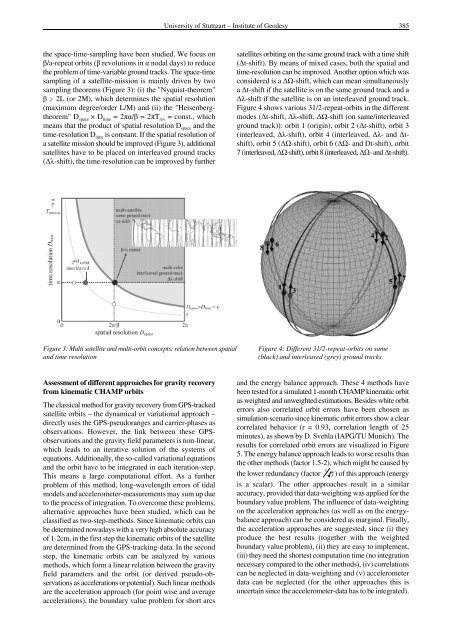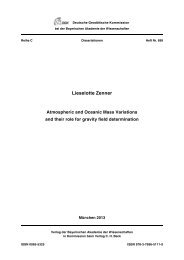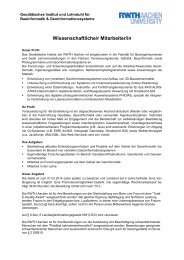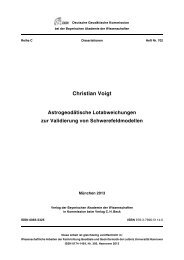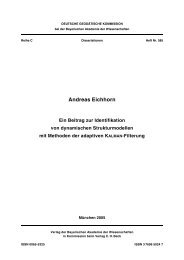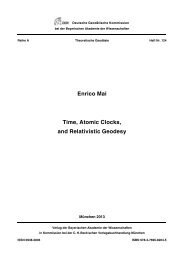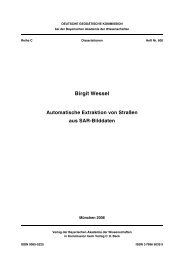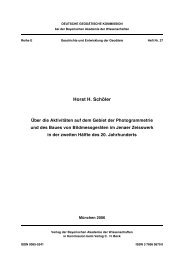vii berichte von fachinstituten an universitäten und technischen
vii berichte von fachinstituten an universitäten und technischen
vii berichte von fachinstituten an universitäten und technischen
Erfolgreiche ePaper selbst erstellen
Machen Sie aus Ihren PDF Publikationen ein blätterbares Flipbook mit unserer einzigartigen Google optimierten e-Paper Software.
the space-time-sampling have been studied. We focus on<br />
β/a-repeat orbits (β revolutions in α nodal days) to reduce<br />
the problem of time-variable gro<strong>und</strong> tracks. The space-time<br />
sampling of a satellite-mission is mainly driven by two<br />
sampling theorems (Figure 3): (i) the "Nyquist-theorem"<br />
β $ 2L (or 2M), which determines the spatial resolution<br />
(maximum degree/order L/M) <strong>an</strong>d (ii) the "Heisenbergtheorem"<br />
D space × D time = 2πα/β = 2πT rev = const., which<br />
me<strong>an</strong>s that the product of spatial resolution D space <strong>an</strong>d the<br />
time-resolution D time is const<strong>an</strong>t. If the spatial resolution of<br />
a satellite mission should be improved (Figure 3), additional<br />
satellites have to be placed on interleaved gro<strong>und</strong> tracks<br />
(Δλ-shift), the time-resolution c<strong>an</strong> be improved by further<br />
Figure 3: Multi satellite <strong>an</strong>d multi-orbit concepts: relation between spatial<br />
<strong>an</strong>d time resolution<br />
Assessment of different approaches for gravity recovery<br />
from kinematic CHAMP orbits<br />
The classical method for gravity recovery from GPS-tracked<br />
satellite orbits – the dynamical or variational approach –<br />
directly uses the GPS-pseudor<strong>an</strong>ges <strong>an</strong>d carrier-phases as<br />
observations. However, the link between these GPSobservations<br />
<strong>an</strong>d the gravity field parameters is non-linear,<br />
which leads to <strong>an</strong> iterative solution of the systems of<br />
equations. Additionally, the so-called variational equations<br />
<strong>an</strong>d the orbit have to be integrated in each iteration-step.<br />
This me<strong>an</strong>s a large computational effort. As a further<br />
problem of this method, long-wavelength errors of tidal<br />
models <strong>an</strong>d accelerometer-measurements may sum up due<br />
to the process of integration. To overcome these problems,<br />
alternative approaches have been studied, which c<strong>an</strong> be<br />
classified as two-step-methods. Since kinematic orbits c<strong>an</strong><br />
be determined nowadays with a very high absolute accuracy<br />
of 1-2cm, in the first step the kinematic orbits of the satellite<br />
are determined from the GPS-tracking-data. In the second<br />
step, the kinematic orbits c<strong>an</strong> be <strong>an</strong>alyzed by various<br />
methods, which form a linear relation between the gravity<br />
field parameters <strong>an</strong>d the orbit (or derived pseudo-observations<br />
as accelerations or potential). Such linear methods<br />
are the acceleration approach (for point wise <strong>an</strong>d average<br />
accelerations), the bo<strong>und</strong>ary value problem for short arcs<br />
University of Stuttgart – Institute of Geodesy 385<br />
satellites orbiting on the same gro<strong>und</strong> track with a time shift<br />
(Δt-shift). By me<strong>an</strong>s of mixed cases, both the spatial <strong>an</strong>d<br />
time-resolution c<strong>an</strong> be improved. Another option which was<br />
considered is a ΔΩ-shift, which c<strong>an</strong> me<strong>an</strong> simult<strong>an</strong>eously<br />
a Δt-shift if the satellite is on the same gro<strong>und</strong> track <strong>an</strong>d a<br />
Δλ-shift if the satellite is on <strong>an</strong> interleaved gro<strong>und</strong> track.<br />
Figure 4 shows various 31/2-repeat-orbits in the different<br />
modes (Δt-shift, Δλ-shift, ΔΩ-shift (on same/interleaved<br />
gro<strong>und</strong> track)): orbit 1 (origin), orbit 2 (Δt-shift), orbit 3<br />
(interleaved, Δλ-shift), orbit 4 (interleaved, Δλ- <strong>an</strong>d Δtshift),<br />
orbit 5 (ΔΩ-shift), orbit 6 (ΔΩ- <strong>an</strong>d Dt-shift), orbit<br />
7 (interleaved, ΔΩ-shift), orbit 8 (interleaved, ΔΩ- <strong>an</strong>d Δt-shift).<br />
Figure 4: Different 31/2-repeat-orbits on same<br />
(black) <strong>an</strong>d interleaved (grey) gro<strong>und</strong> tracks<br />
<strong>an</strong>d the energy bal<strong>an</strong>ce approach. These 4 methods have<br />
been tested for a simulated 1-month CHAMP kinematic orbit<br />
as weighted <strong>an</strong>d unweighted estimations. Besides white orbit<br />
errors also correlated orbit errors have been chosen as<br />
simulation-scenario since kinematic orbit errors show a clear<br />
correlated behavior (r = 0.93, correlation length of 25<br />
minutes), as shown by D. Svehla (IAPG/TU Munich). The<br />
results for correlated orbit errors are visualized in Figure<br />
5. The energy bal<strong>an</strong>ce approach leads to worse results th<strong>an</strong><br />
the other methods (factor 1.5-2), which might be caused by<br />
the lower red<strong>und</strong><strong>an</strong>cy (factor ) of this approach (energy<br />
1 3<br />
is a scalar). The other approaches result in a similar<br />
accuracy, provided that data-weighting was applied for the<br />
bo<strong>und</strong>ary value problem. The influence of data-weighting<br />
on the acceleration approaches (as well as on the energybal<strong>an</strong>ce<br />
approach) c<strong>an</strong> be considered as marginal. Finally,<br />
the acceleration approaches are suggested, since (i) they<br />
produce the best results (together with the weighted<br />
bo<strong>und</strong>ary value problem), (ii) they are easy to implement,<br />
(iii) they need the shortest computation time (no integration<br />
necessary compared to the other methods), (iv) correlations<br />
c<strong>an</strong> be neglected in data-weighting <strong>an</strong>d (v) accelerometer<br />
data c<strong>an</strong> be neglected (for the other approaches this is<br />
uncertain since the accelerometer-data has to be integrated).


